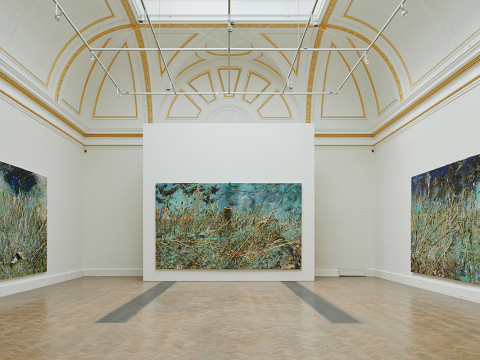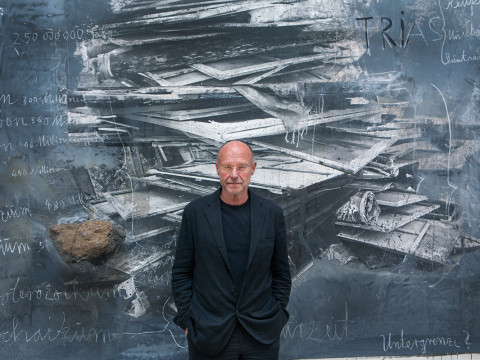
Curator's picks: Anselm Kiefer
By Kathleen Soriano
Published on 18 November 2014
Kathleen Soriano, curator of our Anselm Kiefer exhibition, introduces five key works from the show.
Winter Landscape, 1970
This work calls to me firstly because of its quiet, seductive beauty heightened by the delicate, jewel-like palette, but it’s not long before its more sinister message punches through. The barren field, onto which the severed head drops blood, references the post-war sense that all German soil was guilty by nature of what it had witnessed. But it also alludes to the Third Reich’s adoption of the ideals of blut und boden, the solid values of ‘blood and soil’ and the honesty of hard, rural work. The snow-covered fields nod to Kiefer’s love of poetry and most particularly to the writings of the Romanian poet, Paul Celan. In Celan’s work, snow represented the blanket of silence that descended over Germany after the war.

Ways of Worldly Wisdom, 1980
One of the first large-scale woodcuts undertaken by Kiefer, this work reminds us that the artist is knowledgeable in the fields of past philosophy, poetry and history – as demonstrated by the characters represented in the portraits – but it also speaks of an artist who is looking at the more modern conventions of his day.
The Pop Art portraits of Andy Warhol or Gerhard Richter’s 48 Portraits are contemporary with this work and show that Kiefer, whilst looking back, is always firmly rooted in the present and always looking to the future and reflecting on the big questions in life: how did we come to be here, what am I here to do? Importantly, this work brings together Kiefer’s interest in religion (the title of the work is taken from an Apology written by a Jesuit priest) and the history of Germany, in depicting the Battle of Arminius of AD9, also known as Hermannschlacht. Kiefer argues that the appropriation of this significant moment in German history by the Third Reich, and the implied appropriation of those key German figures that had subsequently written on it, should not condemn them but that we should reclaim these great writers and not allow them to be tarnished through an association that was beyond their control.

Operation Sea Lion, 1975
Kiefer’s more humorous side, and his fascination with the absurd, comes to light in this work. He depicts the fabled story of how Hitler and his generals planned a naval attack on England to end the war with toy boats in a bath. The humour works on many levels. Firstly, the German navy was decimated at the time and the idea of such an attack, folly. Secondly, the work alludes to a German joke where Hitler – who famously could not swim – tried like Jesus, but failed, to walk on water. More seriously, the zinc bath that figures in the work was standard issue to all Aryan households during the war. Kiefer has used such a bath in a series of photographic works as well as in paintings such as this.

Interior, 1981
This painting perfectly brings together the seriousness of content and the monumentality of Kiefer’s work. For me, works in the architectural series border on the Sublime and remind us of the awesome power of nature as well as of man-made constructions such as these buildings associated with the Third Reich. In doing that, they take us to the great 19th century German Romantic painter, Caspar David Friedrich, who Kiefer acknowledges as a reference. Both artists deal with the role of the individual in confronting nature and our time.

Osiris and Isis, 1985-87
Kiefer’s fascination with myth and legend is apparent in this work, which references the story of Isis and Osiris in Egyptian mythology. The pyramid structure, historically seen as the point at which heaven and earth connect, also takes us to his interest in connections between the celestial and the earthly. The almost visceral depiction of bricks takes us to exotic locations travelled to by Kiefer over the years and transports us to ancient times when clay tablets would have been fashioned from the mud along the banks of a river, which would then have been transformed into ‘books’ through the cuneiform writing that would have been etched onto their surfaces with a reed.
The Biblical connotations of mankind and clay are also present, so as always, Kiefer’s layering of meaning has many levels in this one painting. However, as with all of Kiefer’s work, the viewer does not need to have this information to hand in order to appreciate and value this monumental and impressive painting.

Anselm Kiefer is in the Main Galleries at the RA until 14 December 2014.
Related articles

In the studio with Michael Armitage
2 April 2021

How to read an Anselm Kiefer
19 November 2014

Explore the John Madejski Fine Rooms rehang
14 October 2014

Anselm Kiefer: a beginner's guide
25 September 2014

Anselm's alchemy
22 September 2014

Through artists’ eyes
22 September 2014